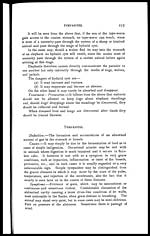Medicine - Veterinary > Veterinary diseases > Elephants and their diseases > Part IV - Non-infective diseases
(336) Page 276
Download files
Individual page:
Thumbnail gallery: Grid view | List view

276 A TREATISE ON ELEPHANTS.
Tonics, especially arsenic, sulphate of iron, copper and nux
vomica, most useful during convalescence.
(4) Bladder worms (Hydatids).—This is a cystic or bladder-like
condition met with in various organs and tissues, but more usually
in the liver, and represents the immature stage of a tape-worm,
which in its mature condition inhabits the bowels of dogs, wolves
and jackals. Its cycle of existence is as follows.
To begin with the egg. This is passed in the faeces of one of
the above animals and may gain entrance to the alimentary canal of
an elephant by its feeding on pasturage, etc., contaminated by their
droppings. The egg having once gained entrance to the stomach
of the elephant, hatches and liberates an embryo, which displays a
desire to migrate, passing through the walls of the stomach, by the
aid of six hooklets with which it is provided, to some suitable spot,
most frequently the liver. Having found a suitable resting place
it casts these hooklets and becomes invested with a fibrous capsule
or wall. At this stage it is known as a hydatid cyst.
The hydatid cyst when fully developed consists of a wall with
fluid contents, and within it other smaller cysts or bladders are
developed, and within these again others may form to a third and
fourth generation. These so-called daughter and grand-daughter
cysts contain fluid and embryo tape-worms, which are called at
this stage " scolices." The scolices consist of a head identical
with the adult tape-worm, a constriction separating it from the body,
and a pedicle or foot which is attached at some stage to the wall
of the cyst, but which frequently gives way setting the " scolex "
free.
The scolex cannot develop further in the elephant. The hydatid
cyst thus affords a haven for the propagation of the species which
can only develop to the stage of "scolices." In doing this it
increases in size, often to an enormous degree. In order to complete
the cycle of the creature's existence the " scolices" must find
their way into the stomach of a dog or kindred animal, which they
usually do by this animal eating the organs or flesh of an animal
infested with hydatids, the sheep perhaps being the most frequent
source.
The scolex having reached the canine stomach becomes endowed
with renewed vitality and develops into a mature tape-worm.
The mature worm consists of a head furnished with four suckers;
two rows of hooklets and three body segments, the last of which is
provided with reproductory organs.
This worm is commonly seen voided with the excreta of dogs
and measures about ¾ inch in length. The adult worm produces
numerous eggs, which are also voided with the dog's excreta.
Set display mode to: Large image | Zoom image | Transcription
Images and transcriptions on this page, including medium image downloads, may be used under the Creative Commons Attribution 4.0 International Licence unless otherwise stated. ![]()
| India Papers > Medicine - Veterinary > Veterinary diseases > Elephants and their diseases > Non-infective diseases > (336) Page 276 |
|---|
| Permanent URL | https://digital.nls.uk/75193068 |
|---|




